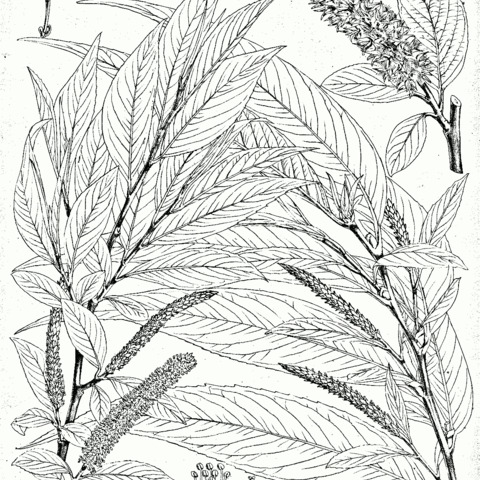Evergreen or (in semi-arid climates) deciduous shrub or small to moderate-sized tree up to 25 by 1 m though generally smaller, branches more or less drooping. Young shoots nearly glabrous to rather densely greyish white-hairy, glabrescent. Stipules small, early caducous or wanting. Leaves (0.5-)1-3(-4) cm petioled, elliptic to lanceolate, variable in shape but nearly always broadest just below or at the middle, (6-)8-16(-24) by (2-) 2.5-4(-6) cm, herbaceous to subcoriaceous, glabrous or glabrescent, sometimes shining on the upper surface, seldom glaucous underneath, base narrowed to rounded, apex acute to acuminate, margin serrulate-denticulate, rarely subentire; the teeth bearing a minute, sessile, dark-coloured gland; midrib prominent, pale, lateral nerves numerous, distinct. Catkins on the twigs of the previous flush, upon short twigs (0-)0.5-2(-3) cm long and with 0-3(-5) caducous leaves, lax-flowered, the ♂ ones more or less pendulous, 4-12 cm long, the female ones more straight, 3-10 cm long, in fruit somewhat longer; rhachis white-tomentose. Male flowers: Bracts elliptic, 1-2(-3) mm long, concave, densely white-haired on both sides; apex rounded, seldom blunt; nerves 3, more or less distinct. Stamens free, 4-15, but on the same plant the variation in number is not beyond 3, sometimes different in length due to unequal development, 3-3½(-4) mm long in anthesis; filaments thin, sometimes sparsely white-haired at the base; anthers elliptic, small, yellow, glabrous. Disk fleshy, variously shaped, adaxial part 0.5-1 mm long and wide, simple to bifid, abaxial part like a small scale adjoining the bract. ♀ Flowers: Bracts as in the male, caducous. Ovary ± 1 mm stalked, conical with rounded base, 3-4 mm long, sometimes short-haired. Style distinct or not, more or less deeply 2-lobed. Disk as in the ♂ flower. Fruit 7 mm long; hairs white, silky, 5 mm long. Seeds 4, elliptic, 2 mm long, grey-blackish brown with lighter rhaphe, somewhat rough when dry, glabrous.
More
Trees to 10 m tall. Branches dull brown, glabrous; juvenile branchlets subglabrous. Buds narrowly ovoid, glabrous, apex acute. Stipules obliquely ovate, glandular, serrate; petiole 1-1.5 cm, glabrous; leaf blade ovate to linear-lanceolate, 6-16 × 2.5-4.5 cm, abaxially pale, pruinose, adaxially green, glabrous, shiny, base cuneate or suborbicular, margin serrate, apex acuminate. Flowering serotinous. Male catkin ca. 10 cm × 6 mm; peduncle 1.5-2 cm, with 2 or 3 pilose leaflets; rachis densely pubescent or woolly; bracts elliptic, densely grayish white downy, apex acute or obtuse. Male flower: glands usually connected, much lobed, discoid; stamens usually 8, rarely 6 or 9; filaments downy proximally; anthers yellow, ovoid. Female catkin nearly as long as male catkin; bracts like those of male catkin, ca. as long as stipes. Female flower: adaxial gland slightly clasping stipe; ovary ovoid, ca. as long as or slightly shorter than stipe; style short, 2-cleft; stigma 2-lobed. Capsule ovoid, glabrous. Fl. Sep-Oct or Jan-Apr, fr. Nov-Dec or May. 2n = 76.
Along water-courses, riverbanks, fringing streamsides and banks of pools and lakes, mostly in the lowlands, ascending in the Himalayas to 2100 m, in Sumatra to 1500 m (Fig. 3), and in the Philippines to medium altitudes
More
Along water-courses, riverbanks, fringing streamsides and banks of pools and lakes, mostly in the lowlands, ascending in the Himalayas to elevations of 2,100 metres.
Uses. In Malaya planted on the dikes of the rice-fields, and by Chinese on embankments of tanks and mines, apparently for protecting the soil, according to Burkill found in every village in some of the northern parts of the Peninsula. It is also sometimes pollarded for forming fences. Propagation is easy by cuttings. It is said to be used against fever; as a matter of fact the crystalline glucosid, salicin, occurs in many Salixes and is a febrifuge. According to Burkill & Haniff ( Burkill & Haniff Gard. Bull. Str. Settl. 6 1930 254 ) a decoction is used cold for ulceration of the nose. Apparently, no one has yet examined the bark for salicin.None of the uses mentioned above have been reported from Java and none is definitely known from the Philippines (cf. Quisumbing Med. Pl. Philip. 1951 220 ). In the latter islands the timber is stated to be occasionally used for house-building purposes.


